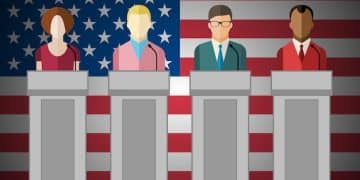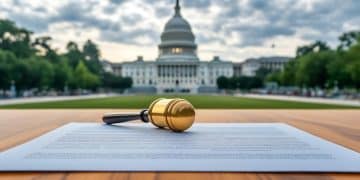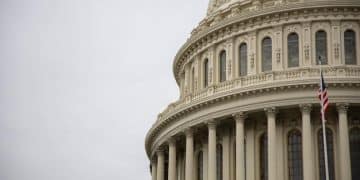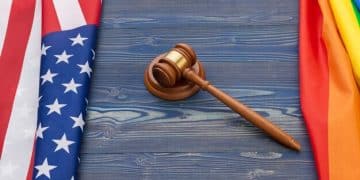Decoding Presidential Executive Orders: Impact on Executive & Legislative Power
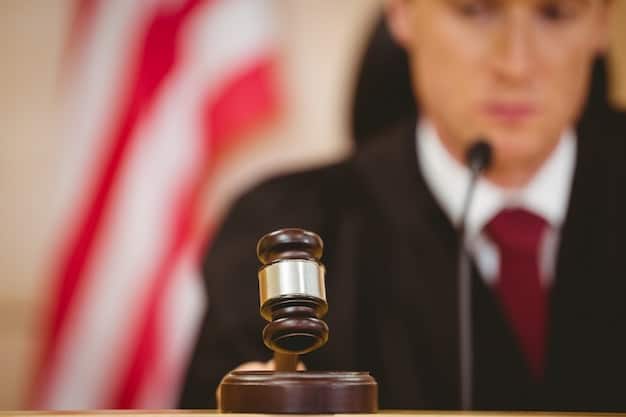
Decoding the latest presidential executive orders involves understanding how these directives can potentially shift the balance of power between the executive and legislative branches, influencing policy implementation and congressional oversight.
In the American political landscape, presidential executive orders are a powerful tool. Decoding the latest presidential executive orders: What do they mean for the balance of power between the executive and legislative branches? Understanding these orders is crucial to assessing their impact on governance.
Understanding Presidential Executive Orders
Presidential executive orders are directives issued by the President of the United States that manage operations of the federal government. They carry the force of law but do not require congressional approval, making them a significant tool for shaping policy.
The use of executive orders has varied significantly throughout American history, with some presidents relying on them extensively, while others have used them more sparingly. These orders can range from relatively minor administrative actions to major policy shifts that impact wide sectors of society and the economy.
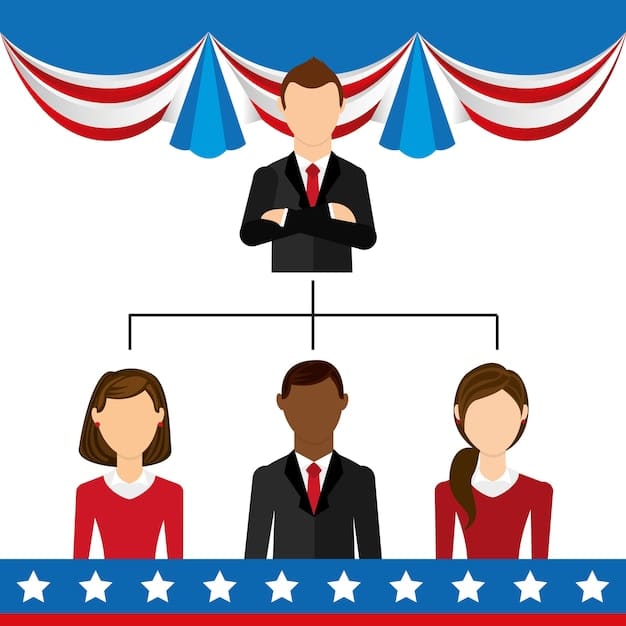
Historical Context of Executive Orders
Executive orders are not explicitly mentioned in the U.S. Constitution, but their legitimacy is generally derived from Article Two, which grants the president executive power. Over time, the Supreme Court has played a role in defining the scope and limits of executive orders, ensuring they do not overstep constitutional boundaries.
- Early Use: Early presidents like George Washington used executive orders primarily for administrative matters.
- Growth in Power: The use of executive orders expanded significantly during the 20th century, particularly under presidents Franklin D. Roosevelt and Harry Truman, who used them to address economic crises and national security concerns.
- Modern Debates: Today, executive orders remain a contentious issue, with debates focusing on their potential to bypass Congress and disrupt the system of checks and balances.
Executive orders offer presidents a means to act swiftly and decisively, especially when Congress is gridlocked or slow to respond to pressing issues. However, this power is not without limitations, as the courts and Congress can challenge or overturn executive orders that are deemed unconstitutional or that exceed presidential authority.
In conclusion, understanding the historical context and legal framework surrounding executive orders is essential for evaluating their role in the balance of power between the executive and legislative branches. This tool allows presidents to implement their policy agendas quickly but also invites scrutiny and potential challenges from other branches of government.
The Legislative Branch’s Role and Response
The legislative branch, primarily Congress, serves as a critical check on the executive power to issue executive orders. While executive orders do not require congressional approval, Congress has several avenues to respond to and potentially counteract presidential directives.
Congress can pass legislation that overrides or modifies an executive order. This process can be challenging, particularly if the president is likely to veto the legislation, requiring a two-thirds majority in both the House and Senate to override the veto.
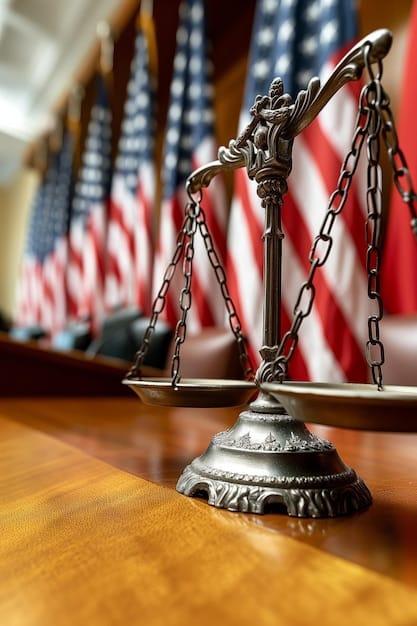
Congressional Oversight and Checks
Congress can also use its oversight powers to investigate the implementation and impact of executive orders. This can involve committee hearings, requests for information, and even the threat of withholding funding for programs created or modified by executive orders.
- Legislative Action: Congress can pass laws to nullify or amend executive orders.
- Oversight Hearings: Congressional committees can hold hearings to scrutinize the use and impact of executive orders.
- Appropriations: Congress controls federal funding and can limit or eliminate funding for initiatives created through executive orders.
The relationship between the executive and legislative branches is inherently dynamic, with each branch vying to protect its constitutional prerogatives. The use of executive orders often becomes a focal point of this tension, with Congress seeking to balance the need for executive action with its responsibility to represent the will of the people and uphold the Constitution.
Consequently, the legislative branch plays a vital role in ensuring that executive orders remain within constitutional bounds and do not unduly infringe on legislative powers. This ongoing interaction between the two branches shapes the trajectory of governance and policy-making in the United States.
Judicial Review and Executive Orders
The judiciary, particularly the Supreme Court, plays a crucial role in checking the power of the executive branch through judicial review. This process allows courts to assess the constitutionality of executive orders and determine whether they exceed the president’s authority.
Judicial review ensures that executive orders do not violate the Constitution or conflict with existing laws. The courts can strike down executive orders that are deemed unconstitutional, providing a significant check on executive power.
Landmark Cases Involving Executive Orders
Several landmark Supreme Court cases have shaped the understanding and limitations of executive orders. These cases have helped define the scope of presidential authority and protect the balance of power between the branches of government.
- Youngstown Sheet & Tube Co. v. Sawyer (1952): This case limited the president’s power to seize private property during wartime, asserting that the president could not act without congressional authorization.
- United States v. Nixon (1974): Although not directly related to an executive order, this case affirmed the principle that the president is not above the law and must comply with judicial subpoenas.
- Trump v. Hawaii (2018): This case involved a challenge to President Trump’s travel ban, with the Court ultimately upholding the president’s authority over immigration but acknowledging the judiciary’s role in reviewing executive actions.
The judiciary offers a vital mechanism for safeguarding constitutional principles and preventing the executive branch from overstepping its bounds. The power of judicial review ensures that executive orders are subject to legal scrutiny, promoting accountability and preserving the rule of law.
In summary, judicial review is a cornerstone of the American system of checks and balances, providing a critical check on executive power and upholding the Constitution’s supremacy.
Public and Political Reactions to Executive Orders
Executive orders often elicit strong reactions from the public and across the political spectrum. The perception and acceptance of these directives largely depend on the specific policies they enact and the political ideologies of those affected. Public reaction can influence the political landscape and shape the broader debate surrounding executive power.
Executive orders can galvanize public support or opposition, leading to demonstrations, protests, and increased political engagement. These reactions can impact a president’s approval ratings and influence the political discourse surrounding their policies.
Impact on Presidential Approval and Political Discourse
The use of executive orders can have a significant impact on presidential approval ratings. While some executive orders may be popular with a president’s base, they can also alienate moderate voters and members of the opposition party.
- Public Perception: The public’s perception of executive orders is often shaped by media coverage and political messaging.
- Political Polarization: Executive orders can exacerbate political polarization, with supporters and opponents becoming more entrenched in their positions.
- Grassroots Movements: Controversial executive orders can spur the formation of grassroots movements aimed at supporting or opposing the policies.
The reactions to executive orders illustrate the complex interplay between executive power, public opinion, and political dynamics. These directives can be powerful tools for advancing policy goals, but they also carry the risk of provoking significant opposition and deepening political divides.
In conclusion, the public and political reactions to executive orders underscore the importance of presidential leadership and the need for clear communication and justification when using executive authority.
Executive Orders and Policy Implementation
Executive orders play a crucial role in the implementation of policies across various sectors, from environmental regulations to immigration policies. These directives enable presidents to direct federal agencies and officials to take specific actions, often leading to swift changes in policy implementation.
The ability to implement policies through executive orders allows presidents to bypass legislative gridlock and address urgent issues quickly. However, this approach can also be seen as circumventing the democratic process.
Examples of Policy Changes Through Executive Orders
Numerous executive orders throughout history have led to significant policy changes. These examples illustrate the breadth and magnitude of the impact executive orders can have on American society.
- Environmental Regulations: Several presidents have used executive orders to establish national monuments, protect endangered species, and regulate pollution.
- Immigration Policies: Executive orders have been used to modify immigration enforcement policies, prioritize deportations, and provide temporary relief to certain groups of immigrants.
- Economic Policies: Presidents have issued executive orders to freeze federal hiring, regulate financial institutions, and promote fair labor practices.
Executive orders offer presidents a powerful tool for shaping policy outcomes and driving change across various sectors. While they can be effective in addressing immediate needs and overcoming legislative obstacles, their use also raises questions about executive overreach and the balance of power within the government.
In summary, executive orders are an important instrument for policy implementation, enabling presidents to act decisively but also requiring careful consideration of their potential impact on the separation of powers and the rule of law.
The Future of Executive Orders in American Governance
The role and significance of executive orders in American governance are likely to evolve in response to changing political dynamics and societal needs. As political polarization continues and legislative gridlock persists, presidents may increasingly rely on executive orders to advance their policy agendas. Understanding the potential future implications of this trend is crucial for preserving the integrity of the U.S. system of checks and balances.
The future use of executive orders will likely be shaped by ongoing debates about executive power and the appropriate balance between the executive and legislative branches. The judiciary will continue to play a vital role in defining the limits of presidential authority.
Potential Reforms and Limitations
Several potential reforms and limitations could be considered to address concerns about executive overreach and promote greater accountability in the use of executive orders. These measures could help ensure that executive orders are used judiciously and do not unduly infringe on legislative powers.
- Congressional Review: Establishing a formal mechanism for congressional review of executive orders could provide an additional check on executive power.
- Judicial Scrutiny: Strengthening the judiciary’s role in scrutinizing executive orders could help ensure they comply with constitutional principles.
- Transparency: Improving transparency in the issuance and implementation of executive orders could promote greater public awareness and accountability.
The future of executive orders in American governance will depend on the collective efforts of the executive, legislative, and judicial branches to uphold the Constitution and preserve the balance of power. By engaging in constructive dialogue and considering potential reforms, these branches can help ensure that executive orders remain a valuable tool for effective governance while safeguarding democratic principles.
In conclusion, the future of executive orders is intertwined with the ongoing evolution of American governance and the enduring quest to balance executive power with the protection of individual rights and legislative prerogatives.
| Key Point | Brief Description |
|---|---|
| 📜 Executive Orders | Directives issued by the President to manage federal operations. |
| 🏛️ Legislative Checks | Congress can override or modify executive orders through legislation. |
| ⚖️ Judicial Review | Courts assess the constitutionality of executive orders. |
| 📢 Public Reaction | Public response can significantly influence the political landscape and debates. |
Frequently Asked Questions
▼
An executive order is a directive issued by the President of the United States that manages operations of the federal government. It has the force of law but doesn’t require congressional approval.
▼
Congress can check an executive order by passing legislation that overrides or modifies it. They can also limit funding or conduct oversight hearings to scrutinize the order’s impact.
▼
Yes, the Supreme Court can overrule an executive order if it finds that the order is unconstitutional or exceeds the president’s authority. This is part of the judicial review process.
▼
Generally, executive orders do not require public comment periods in the same way that regulations proposed by federal agencies do. However, transparency can vary depending on the order.
▼
A new president can modify, revoke, or leave in place executive orders issued by previous presidents. This often depends on the new president’s policy priorities and political agenda.
Conclusion
In conclusion, understanding the dynamics surrounding presidential executive orders is crucial for grasping the nuances of the American political system. These orders represent a powerful tool for presidents, but they are also subject to checks and balances from the legislative and judicial branches, as well as scrutiny from the public. The ongoing interplay between these forces shapes the landscape of American governance and policy-making.
